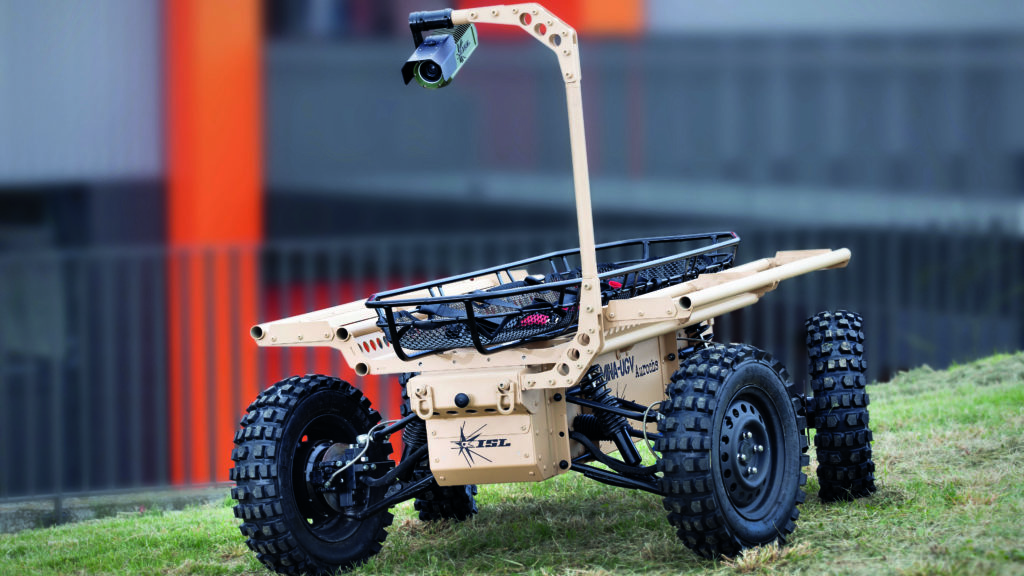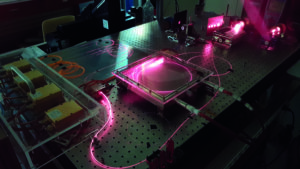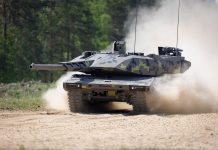The list of capability requirements for the future Main Ground Combat System (MGCS) is long. It must detect and identify threats from a distance, improve crew protection, increase firepower and mobility, and so forth. Many technological challenges have to be overcome.
The French-German Research Institute of Saint-Louis (ISL) has extensive experience and a long history of technological innovation in the field of armaments, and therefore has the requisite scientific portfolio to make a substantial contribution to this large-scale research and development project.
The Battle Tank, a Symbol of the Past with Great Prospects
 The fall of the Berlin Wall symbolised the end of the Cold War and appeared to herald the demise of heavy battle tanks. During the “peace dividend” years, political and military analysts considered the battle tank a weapon of the past. For them, battle tanks were out of date in the new asymmetric conflicts, such as the fight against terrorism. Like dinosaurs, these heavy vehicles were doomed to extinction and expected to disappear from 21st century battlefields.
The fall of the Berlin Wall symbolised the end of the Cold War and appeared to herald the demise of heavy battle tanks. During the “peace dividend” years, political and military analysts considered the battle tank a weapon of the past. For them, battle tanks were out of date in the new asymmetric conflicts, such as the fight against terrorism. Like dinosaurs, these heavy vehicles were doomed to extinction and expected to disappear from 21st century battlefields.
This assessment has now been proven wrong in two respects. First, recent geopolitical tensions have sparked fears of a return of symmetric conflict (e.g. in the Donbass region). Second, the remarkable combination of mobility, firepower and protection provided by the heavy battle tank is still unrivalled in ground warfare. In a historical twist of fate, in 2015, it was Russia, the former adversary, which showed that battle tanks had been written off too quickly. The demonstration of Russia’s new T-14 ARMATA tank caused a sensation. Experts soon agreed that this new weapon would outperform NATO’s best heavy battle tanks and be hard to beat technologically.
The Franco-German MGCS Project
The Leopard 2 and Leclerc battle tanks used by the German and French armies were designed in the 1980s. Their combat efficiency has been significantly upgraded since they first came into service. With a view to replacing them by 2035, Germany and France launched an ambitious joint initiative in 2012. Together, they plan to investigate, design and develop the future Main Ground Combat System (MGCS). The project comprises five main stages: operational requirements analysis, concepts study, technology development and demonstration, system integration and demonstration and, lastly, system production. The first two stages have already been successfully completed.
The operational requirements analysis was undertaken in 2013 and 2014 by a Franco-German task force consisting of military and technical experts. Following this, two concept studies were simultaneously conducted in Germany and France between 2015 and 2018. They were carried out at a national level, in Germany by IABG and in France by ISL, under the authority of the respective German and French Defence Ministries. The two task forces met frequently to ensure close interaction and cooperation. These studies resulted in two system concepts, one German and one French, which were very similar in terms of their architecture and features. Both concepts describe a team of combat vehicles that can be remote-controlled or employed in autonomous mode, depending on their subsystem characteristics.
The two concepts that resulted from these studies were chosen to serve as the basis for the development of a common system and for the further development of technologies and capacity certification in the third stage of the MGCS project, which is currently under way.
Innovative Technologies from ISL
The MGCS will consist of a range of vehicles capable of manoeuvring and fighting together. Their firepower and protection capabilities will far outstrip those of a single battle tank. There will be light, medium and heavy, manned and unmanned tanks in a unit, with UAVs for additional support. The various weapon systems inside the land vehicles will be able to defeat all short-, medium- and long-range threats, and the drones will expand the system’s observation capabilities, especially beyond the direct line of sight. The vehicles will offer crews much better protection, which is crucial. They will notably include a survival cell (with the crew sitting inside the chassis), active protection countermeasures and the use of robots. It is, however, important to realise that technology cannot accomplish everything. To expand the system’s potential future applications and help boost cooperative combat capabilities through the use of manned and unmanned vehicles, both countries must continue to evolve their combat doctrines and even introduce innovations.
For years, there has been very little research and development in battle tanks, which is why developing innovative technologies for a future battle tank system might seem challenging. In this regard, it would certainly be helpful to coordinate a national and binational approach, and aim for a consolidated roadmap and more specifically a correlated R&D roadmap in terms of MGCS technologies.
As a Franco-German research institute, ISL is perfectly placed to play a role in this binational program and contribute to the development of innovative MGCS technologies. ISL has the appropriate expertise to conduct research and development, simulations and experiments for all key MGCS features – firepower, protection, mobility and SDRI (Surveillance, Detection, Recognition and Identification) – with a view to either a medium-term (2025) or long-term transfer of technology.
Firepower
In the field of interior ballistics, ISL improves propellant performance by using 3D printing to manufacture new grains geometries and by creating submicron energetic materials. Using a plasma cartridge in an electrothermal-chemical tank gun also improves the powder ignition process, which increases muzzle velocity (up to 2000 m/s in a 120mm gun) and reduces performance differences due to temperature effects.
In the field of external ballistics, ISL can increase the range of direct or indirect fires, while improving the hit probability, thanks to projectile guidance and control. In particular, it has already developed a complete system for the control of a spin-stabilised medium-calibre projectile and tested it successfully on its proving ground. The on-board system consists in a pyrotechnic actuator and a navigation unit based on magnetometers. ISL has also developed aero-mechanical actuators which can correct the course of fin-stabilised projectiles.

In the field of terminal ballistics, ISL develops submicron-sized alternative energetic materials that substantially increase the lethality of ammunition of different calibres, and enable the use of low-cost warhead detonators that are safer, more reliable, more environmentally-friendly and REACH-compliant. In addition, ISL’s current theoretical and experimental research aims to optimise further the characterisation of penetration and impact performance of kinetic penetrators and shaped charges.
Armour Protection
ISL’s work on armoured platform protection includes, on the one hand, long-range protection with active countermeasures and, on the other, protection against direct hits with active and passive protective structures.
IR solid-state and fibre lasers which are designed and developed to dazzle and damage electronic sensors are one of the possible active countermeasures against missile seekers and enemy sighting devices, night-vision devices and thermographic cameras. So far, this technology has mostly been used as a DIRCM application to protect aircraft. ISL has already outlined some application ideas for its use by ground forces.
When it comes to the development of advanced protective materials, ISL focuses on three areas of activity:
- ballistic protection of the crew and their equipment
- protection of optic equipment against laser threats
- investigation of ageing effects on material properties
To improve ballistic protection, ISL develops low-weight, high-mechanical-resistance materials, such as multilayer composites made of metal-ceramic or metal-polymer compounds which are obtained by sintering of extremely fine powders.
ISL applies knowledge about terminal ballistic effects from different kinds of threats (blasts, fragments, long-rod penetrators) to optimise the armour protection of protected platforms. Numerical simulations and firing tests serve to investigate the interaction between threats coming from different projectiles or shock waves and passive, reactive or active armours. Newly developed and secure opto-pyrotechnical detonators, which are exclusively based on secondary explosives, offer a reliable solution for the initiation of pyrotechnical components in active protection systems.
ISL develops new types of materials with non-linear optic properties to face laser threats. These materials reduce the incident laser beam significantly and behave somewhat like photochromic glass. Non-optic materials also reduce thermal laser threats thanks to new types of sintered, heat-resistant polymers.
It is a well-known fact that ageing alters materials (embrittlement of plastic, delamination). The latest research in this area investigates the effects of ageing on the protective properties of materials. It enables an assessment of the long-term effectiveness of the protection, and determines the moment when protective materials should definitely be replaced.
Steps Toward Semi-Autonomous Mobility
The image-based navigation system STAMINA enables ground vehicles to move without any satellite positioning. This navigation system is not sensitive to jamming or interferences from GNSS-signals (GPS, Galileo). It can follow an itinerary determined by a simple sequence of images while avoiding potential obstacles. As well as its integration into MGCS vehicles, it has multiple civil and military applications for ground robots: freight transportation systems, autonomous emergency vehicles serving different purposes and patrol vehicles for the surveillance of critical areas.
These vehicles are also capable of detecting changes in their surroundings and can provide the operator with valuable information when it comes to the detection of suspicious objects (i.e. IEDs).
SDRI
Optical and acoustic surveillance methods help improve tactical reconnaissance on the battlefield. They are an absolute necessity for future combat vehicles, since they allow the crew inside the survival cell to stay in contact with the outside world and react appropriately to the situation.
Optical surveillance using time-gated imaging in the infrared range enables users to continue to observe the surroundings even in harsh visibility conditions (smoke, fog, rain, snow, etc.). This technology captures objects from the original scene precisely and recreates a 3D image in real-time. ISL is currently developing a new image processing method that combines laser illumination and image processing to detect and track objects which are not in the direct line of sight (“see around the corner”).

ISL uses specific machine learning processors to develop autonomous surveillance systems capable of detecting, analysing and classifying specific visual events in real time, such as people or vehicles trying to enter a protected zone. In acoustics, sensor networks can already detect approaching threats from any direction. This includes threats which are difficult to detect such as UAVs. By combining acoustic warning sensors with an active imaging system, a complete system for the surveillance, detection and localisation of drones can be implemented. Furthermore, AI techniques such as deep learning can be used to improve the system performances thanks to automatic UAVs identification and tracking functions.
In the field of acoustics, ISL’s latest developments include a new generation of earplug hearing protection devices. These protect soldiers from the impulse noise produced by weapons, improve their hearing and communication abilities, measure their vital functions, and provide spatial cognition and situational awareness capabilities that are unattainable with conventional noise protection devices. The three-dimensional detection of acoustic sources in an urban environment and acoustic signature reduction are the main objectives of these acoustic technologies.
Abstract
The ambitious Franco-German MGCS (Main Ground Combat System) project is the ground combat system of the future. It will come into service between 2030 and 2040 and will continue to support ground forces in subsequent decades, serving as their main combat system. The system’s requirements are one of the major challenges facing its technological implementation. They include the need for it to be inherently dynamic and scalable to current and future operation scenarios, as well as adaptable to future technologies used in upgrade programmes.
ISL technologies are already available in a national and binational context. They can be immediately integrated into an MGCS. Furthermore, existing technologies must be improved for use in a military context. New technologies which could close capability gaps need to be identified and implemented so the system can adapt to future technical and operational developments.
First and foremost, the MGCS of the future must be fitted with the latest available equipment in a timely manner. ISL’s scientific portfolio already provides a solid basis for this and ISL is therefore well-placed to take on this challenge.
Brigadier General Dr.-Ing. Thomas Czirwitzky is the German director of the German-French Research Institute Saint-Louis (ISL) and Dipl.-Ing. Pierre Wey is a senior Scientist at ISL and Project Director MGCS.










